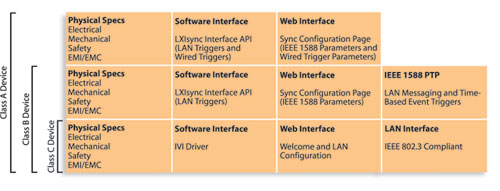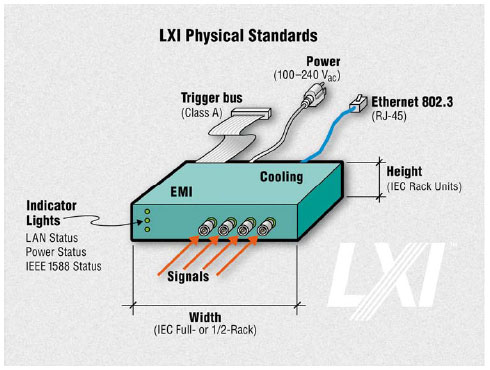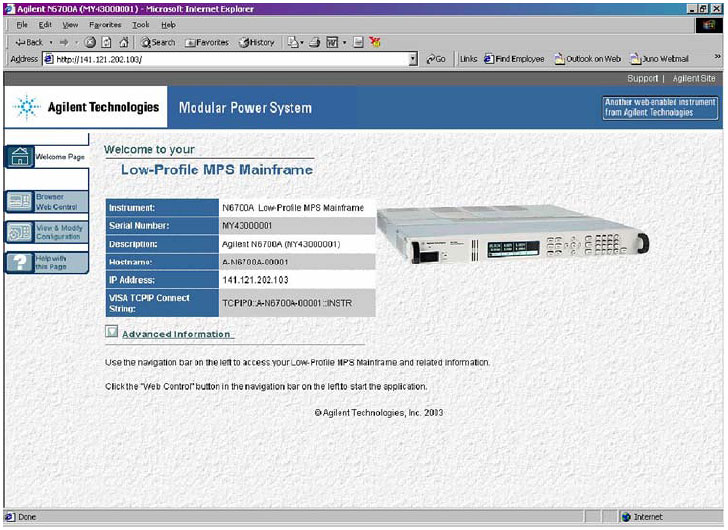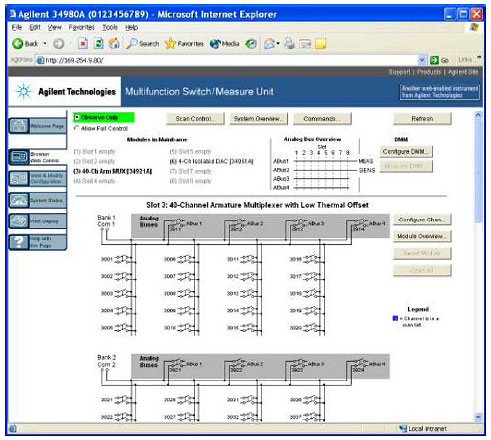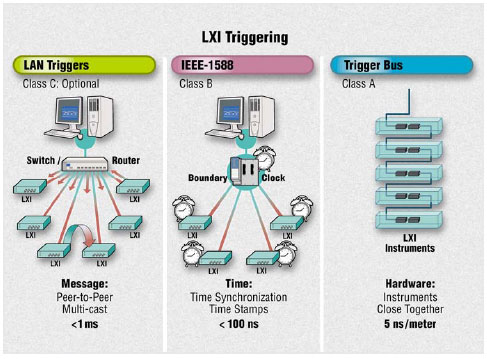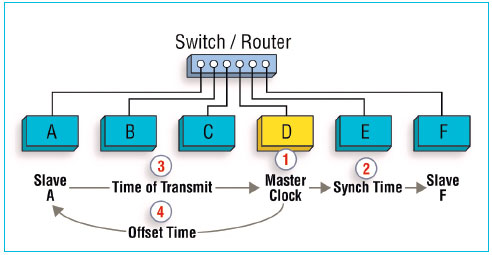 |
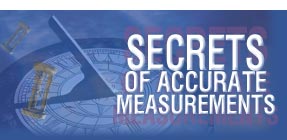 |
 |
| RU |
|
Login
Newsletters
There is no newsletter category found. Information
|
LXI Standard LAN (eXtensions for Instrumentation) is a standard developed by the LXI Consortium, an industry consortium that maintains the LXI specification, promotes the LXI Standard, and ensures interoperability. The LXI standard defines the communications protocols for instrumentation and data acquisition systems using Ethernet. Ethernet is an accessible and versatile interface, that must be implemented against a standard for instrumentation to communicate effectively. The LXI Consortium provides the structure that ensures instrumentation developed by various vendors' works effectively as long as the instruments are compliant. The LXI Consortium ensures that the LXI standard complements Test and Measurement systems, such as existing GPIB and PXI systems. [1] LXI is the next generation of test systems combining state-of-the-art measurements in a small package at a cost-effective price. LXI modules are full-rack width, 1U tall or half-rack width, 1U or 2U tall. Signals enter and exit the module fr om its front panel while LAN (IEEE 802.3), power, and trigger cables are found on the back of the module. All modules are designed to be easily mounted in a standard 19" rack or stacked on the bench. [2]
Example of an LXI system including conformant LXI Devices and non-LXI instruments The LXI Standard defines devices using open-standard LAN (Ethernet) for system inter-device communication. The standard will evolve to take advantage of current and future LAN capabilities. It provides capabilities that go well beyond the capability of other test and measurement connectivity solutions. It will provide users with solutions that are denser, smaller, faster, and cheaper than other solutions. [3] InteroperabilityLXI devices can communicate with devices that are not themselves LXI compliant, as well as instruments that employ GPIB, VXI, and PXI, into heterogeneous configurations. In order to simplify communication with non-LXI instruments, the standard mandates that every LXI instrument must have an Interchangeable Virtual Instrument (IVI) driver. The IVI Foundation defines a standard driver application programming interface (API) for programmable instruments. There are currently two IVI driver formats: IVI-COM for working with COM-based development environments and IVI-C for working in traditional programming languages. Most LXI instruments can be programmed with methods other than IVI, so it's not mandatory to work with an IVI driver; developers can use other driver technologies or work directly with SCPI commands. [1] Industry consortiumThe LXI Consortium is a not-for-profit corporation made up of test and measurement companies. The Consortium's primary purpose is to promote the development and adoption of the LXI Standard, an open, accessible standard identifying specifications and solutions relating to the functional test, measurement, and data acquisition industry. The Consortium is open to all test and measurement companies, and participation by industry professionals, systems integrators, and government representatives. The first Consortium meeting was held November 17-18, 2004. Membership is divided into four levels: Strategic, Participating, Advisory, and Informational. Consortium members meet several times a year at PlugFests held around the world where conversations regarding the LXI Standard are discussed at face-to-face meetings in working groups. The public is invited to attend tutorials intended for users and manufacturers interested in joining the LXI ranks. PlugFests keep LXI instrument manufacturers current with changes in the specification, test implementations. It also provides an opportunity for certifying new products as LXI conformant via an independent testing lab. The Consortium's standard development efforts are performed by volunteers working through a number of committees and technical working groups (WGs), which include Compliance WG, LAN and Web WG, Physical WG, Programmatic Interface WG, Resource Management WG, Specification Revisions, Technical Committee, and Timing and Synchronization. [1] History of LXI
In addition to XML-based discovery, Version 2.0 of the Standard will incorporate even more significant changes. This functionality include the extension of LXI device Web pages to support instrument configuration and interactive testing of different LXI trigger capabilities such as LAN peer-to-peer messages, IEEE 1588 time events, or the wired trigger bus of LXI Class A devices. Logging of all the events in LXI devices will improve as will the ease of troubleshooting LXI-based test systems. Resource Management is another major extension that enables management and allocation of LXI devices in a network with more than one controller accessing instruments. Yet another working group is dealing with the standardization of script downloads into LXI devices. Execution of custom scripts can be done without the system controller, simplifying the development of test software and increasing the throughput of test systems. The most current version of the standard (Version 1.3) is available on the LXI Consortium's website). [1] StandardizationThe LXI Standard has three key functional attributes:
Overview of device classesClass C is the baseline with LAN capabilities, a Web interface, and IVI drivers. Class B adds expanded triggering, such as multicast and peer-to-peer communications between instruments and time-based trigger events. The time-based triggering is made possible by implementing the PTP, which can distribute a precision timing source across many Class A and B devices over a LAN. Class A devices build upon Class B devices by adding a wired trigger bus for precision triggering. [1]
LXI Functional Class Models The Functional classes do not imply any particular physical size for an LXI Device. Functional Class CClass C LXI Devices provide a standardized LAN and web browser interface that is conformant with the LXI Standard. This class is particularly suited to applications where non-LXI products have been adapted to the standard, but it is also well suited to applications where there is no necessity to offer triggered or timed functionality. This class may also include physically small products, such as sensors, that use battery power or PoE (Power over Ethernet) wh ere simple device architecture, low cost and small size are key attributes. Functional Class BIn addition to Class C features, Class B LXI Devices provide a standardized LXI Event interface, synchronization API and support the IEEE 1588 timing aspects. The IEEE 1588 interface allows devices to execute triggered functions equivalent to those available over GPIB and with similar or better timing accuracy. Functional Class AIn addition to Class B features, Class A LXI Devices provide a wired trigger bus interface. The LXI Trigger Bus provides a standardized capability of supporting trigger events between devices whose timing accuracy is limited by the physical lim itations of cables and LXI Device hardware. The trigger functionality is broadly equivalent to the backplane triggers of modular instruments in card cages, though cable lengths may typically be longer than backplane trigger lengths. [3]
LXI Device Class Hierarchy [9] LXI InterfacesAdopting any new standard requires some level of change and an associated learning curve, but LXI has the advantage of using the most prolific communications standard in the world as the underlying foundation. The key features of LXI that make smart instruments possible include the following:
1) Physical interface
Physical interface
The flexibility of the standard allows instrument suppliers to adopt IEC 60297 for 19-in. rack-mount units or alternatively a half-rack configuration. This latter opportunity gives implementers the opportunity to adopt a defacto standard or use the LXI-unit standard as defined in the specification, providing a large amount of flexibility when establishing a mechanical package size and configuration. [4] CoolingLXI modules provide their own cooling. The devices take air in from the sides and exhaust it out the rear. Half-rack modules are designed so adequate cooling is maintained even if one side of the module is completely blocked by an instrument sitting next to it in the rack. [8] ElectricalLXI modules must adhere to the CSA, EN, UL, and IEC standards of the region or market they serve. Modules are powered from standard single-phase sources of 100 to 240 V AC at 47 to 66 Hz. The specification makes provisions for devices to be powered via DC voltages or Power over Ethernet (POE). [8] Switches and IndicatorsThe LXI specification standardizes the type and location of switches, cables, and indicators. The Ethernet connection (RJ-45) is located on the left side of the rear panel while the power connector is located on the right side. The power switch is next to the power connector in the lower right corner of the rear panel. The trigger bus connectors are on the right side of the rear panel next to the power. Each LXI module without a front panel must have a LAN configuration initialize (LCI) button, preferably on the rear panel. The button should be labeled LAN RST or LAN RESET and protected with mechanical protection or a time delay to prevent inadvertent operation. The LCI must put the module into a known state in case the module loses communications with the PC. The signal connections to an LXI module are located on the front panel. When the LXI device does not have a front-panel display, it must have three indicator lights in the lower left corner:
1) LAN interfaceLXI adds some additional features to standalone LAN instruments, such as a standard HTML configuration page, and several best practices for implementing LAN instruments. LXI also adds optional timing and synchronization features including IEEE-1588 Precision Time Protocol and a bussed Hardware Trigger (These features are required in certain classes of LXI instruments). Using specialized LAN hardware, IEEE-1588 devices are capable of achieving synchronization in time of within +-100 ns. This capability makes IEEE-1588 attractive for applications with relatively low acquisition rates (below 1 MS/s) that require synchronization over large distances. Most LXI instruments will look very similar to existing LAN implementations, in fact, a majority of current LXI devices are updated versions of existing products. LXI devices that implement the optional synchronization capabilities are well-suited to applications that require instruments to be distributed over large distances. [7] A Comparison of LAN and LXI instrument features.
Every LXI device must implement IEEE 802.3. The network must support TCP/IP with IPv4 at a minimum. The spec recommends Gigabit (1000Base-T) Ethernet that negotiates down to 100Base-T and that users should build their network with CAT 5 cable and infrastructure to support 100Base-T at a minimum. Although 10Base-T is permitted, it is expected that nearly all vendors will provide 100Base-T at a minimum. At 100-Mb/s, LXI is roughly 12 times faster than GPIB. [8] The maximum cable length for any segment of a LAN is 100 meters with 10/100Base-T hubs extending this distance to approximately 1,600 meters. With routers, switches, bridges, and repeaters, a LAN segment can essentially have unlim ited length, a clear advantage over a GPIB network topology. [4] LAN features:
2) Software interfaceAll LXI-compliant instrumentation is required to furnish an IVI driver: IVI-C or IVI-COM. This provides the flexibility to choose the development environment best suited to the application. These drivers can be used in a number of application programming environments such as C/C++, MatLAB, Visual Basic, VEE, and LabVIEW/LabWindows CVI. It also is possible to port instrument functionality into non-Windows based environments when source code is provided by the manufacturer. [10] 3) Web-InterfaceImagine being able to monitor a test system from the comfort of your office when the instrument might be 100 feet away, 100 miles, or halfway around the world. That' s one key benefit of LXI instruments. The built-in web server gives users an easy way to configure, learn, access remotely, and even assist in programming the product. Virtually no software installation is required to start using the instrument. If your computer has a LAN port, a LAN cable, and virtually any web browser, you can connect to the instrument. The IP address is all you need to connect a web browser to the instrume. Manufacturers use different color schemes and templates to give a unique look and feel to their family of instruments, but the information presented on the home page adheres to the LXI spec. It includes manufacturer, product description, serial number, host name, VISA programming string, Telnet port, socket port, MAC address, IP address. [11]
Web Interfaces for Agilent N6700A (Low-Profile MPS Mainfraim) and 34980A (Multifunction Switch Measure Unit) The LXI standard requires that all LXI devices serve up a Web page with key information about the product. It must be viewable from a standard W3C Web browser and conform to HTTP 1.1 with hypertext markup language (HTML) pages of version 4.01 or later. The model number, firmware revision, manufacturer, IP address, and basic configuration information are required. In some cases, module manufacturers will build a complete user interface that can configure the instrument and view results using a standard Web browser. While the home page, the associated communications configuration, and help pages all must be HTML based, the Browser Web Control pages can be Java scripts, Java applets, and flash programs. Java applets and flash programs are executed by browser plug-ins, which means you might have to load some additional software on the PC before controlling instruments using such programs. [11] 4) SynchronizationThe LXI standard has three classes of products based mainly on the types of triggers they implement:
LXI Triggering The IEEE 1588 (time synchronization of networked devices) standard is based on technology developed by Agilent Labs over the past 10 years. The protocol designates one device as the master clock and proceeds to synchronize the clocks of other devices on the network. [8]
Synchronization
Over the course of a few seconds, the master clock and the slaves are synchronized to 100-ns accuracy or less, depending on the accuracies of the clocks. Triggering of devices is performed by telling each device when to start its measurement or signal output activity. LAN overhead or latency has no bearing on the devices being triggered because they all start their activity based on time, not on when they receive a command over LAN. With IEEE 1588, the need for trigger lines is eliminated because triggering is set via time. This method opens up the possibility of synchronizing measurements across instruments that are not physically next to each other and provides a very precise means to correlate measurements across multiple instruments. It may very well become the defacto standard for applications that require precise correlation of signals and measurements.[8] LXI FeaturesLXI Devices are designed to provide a dense and compact solution for test systems. Many LXI Devices will provide only minimal manual user interfaces to reduce device complexity and space. Many LXI Devices are expected to be 1U to 4U high and half rack width, but devices occupying a full rack width are expected to be implemented for many applications, particularly more complex functions. Some LXI Devices, such as sensors, may be much smaller and have mechanical dimensions not intended for rack mounting. User connections to LXI Devices are recommended to be on the front while LAN, trigger and power supply connections are on the rear. Indicator lights on the front panel show the presence of power and have a LAN status indicator to ensure users can quickly spot simple functional or connectivity problems. A recommended indicator shows the operating condition of the IEEE 1588 clock system. The LXI Device power can be provided by a standard AC power supply with automatic voltage selection or by a DC power source. Alternatively an isolated DC input connection can be provided (or a Power Over Ethernet source for lower power LXI Devices) for applications wh ere AC supply operation is not desirable. A 48 V isolated supply is recommended for these applications to align with the standards for Power Over Ethernet, but other voltages are permitted. LXI Devices are expected to conform to the relevant standards applicable for intended markets for safety and environmental standards. [3] Compliant instrumentsThe number of LXI-compliant instruments has grown dramatically, starting from a handful of products from just two vendors in December 2005. This expansion in instrument availability is seen as likely to speed widespread acceptance of the LXI platform and encourage migration to LXI from older instrument platforms. As of March 2009, the Consortium had certified 1,117 instruments fr om 22 manufacturers as compliant with the Standard. [1]
LXI benefits
Member Companies [6]Strategic
Participating
Advisory
Informational
University
Links
Author(s): Afonskiy, Alexander, Novikov, Andrey |
Current issue
Search
|
|
|
| © "Test & Measuring Instruments and Systems" ("KIPiS"), 2000-2024 |
























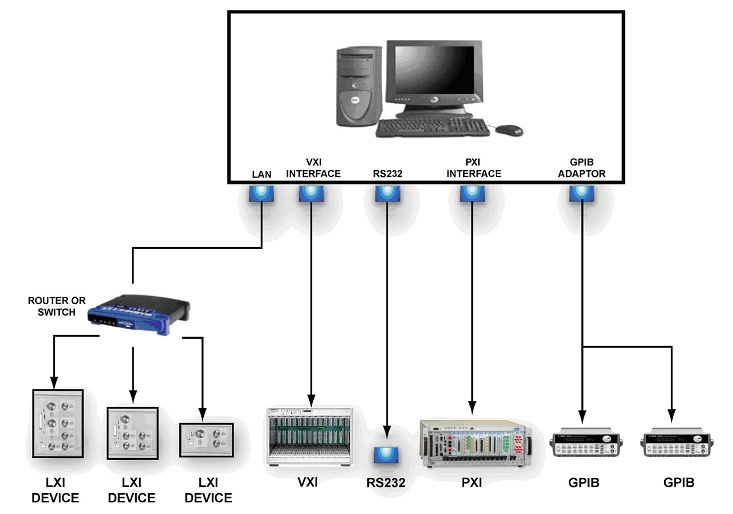
.jpg)
